Product Differentiation: Definition, Strategy and Implementation

"We need to be more innovative than our competitors."
This vague directive lands in your inbox on a Monday morning. On Tuesday, three executives each interpret “innovative” differently. Come Wednesday, your development team starts questioning how these new “innovative” features align with the existing roadmap. Then Thursday hits with customer feedback that contradicts everything.
This fear-of-missing-out-mentality is the death of genuine product differentiation.
When flashy features win over coherent vision, products drift toward mediocrity. Your team builds what sounds good in a stakeholders meeting rather than what creates lasting market separation. Engineers code furiously to match competitor capabilities, while the product’s unique strengths remain underdeveloped.
Product differentiation is your way to break through. It requires a strategic alignment of good ideas with disciplined execution, using market insights to create tangible product features customers truly value.
Platforms like Meegle bring structure to this complex, iterative process, helping teams focus on calculated differentiation rather than reactive feature development.
In this guide, we'll walk through what product differentiation means. You'll learn how to use psychological insights to influence buyer decisions, explore types and strategies tailored to your market, and follow a step-by-step playbook to implement differentiation.
What is product differentiation?
Product differentiation is the strategic process of distinguishing your product from competitors in the market. It is the answer to: “Why pick your tool over the rest?”
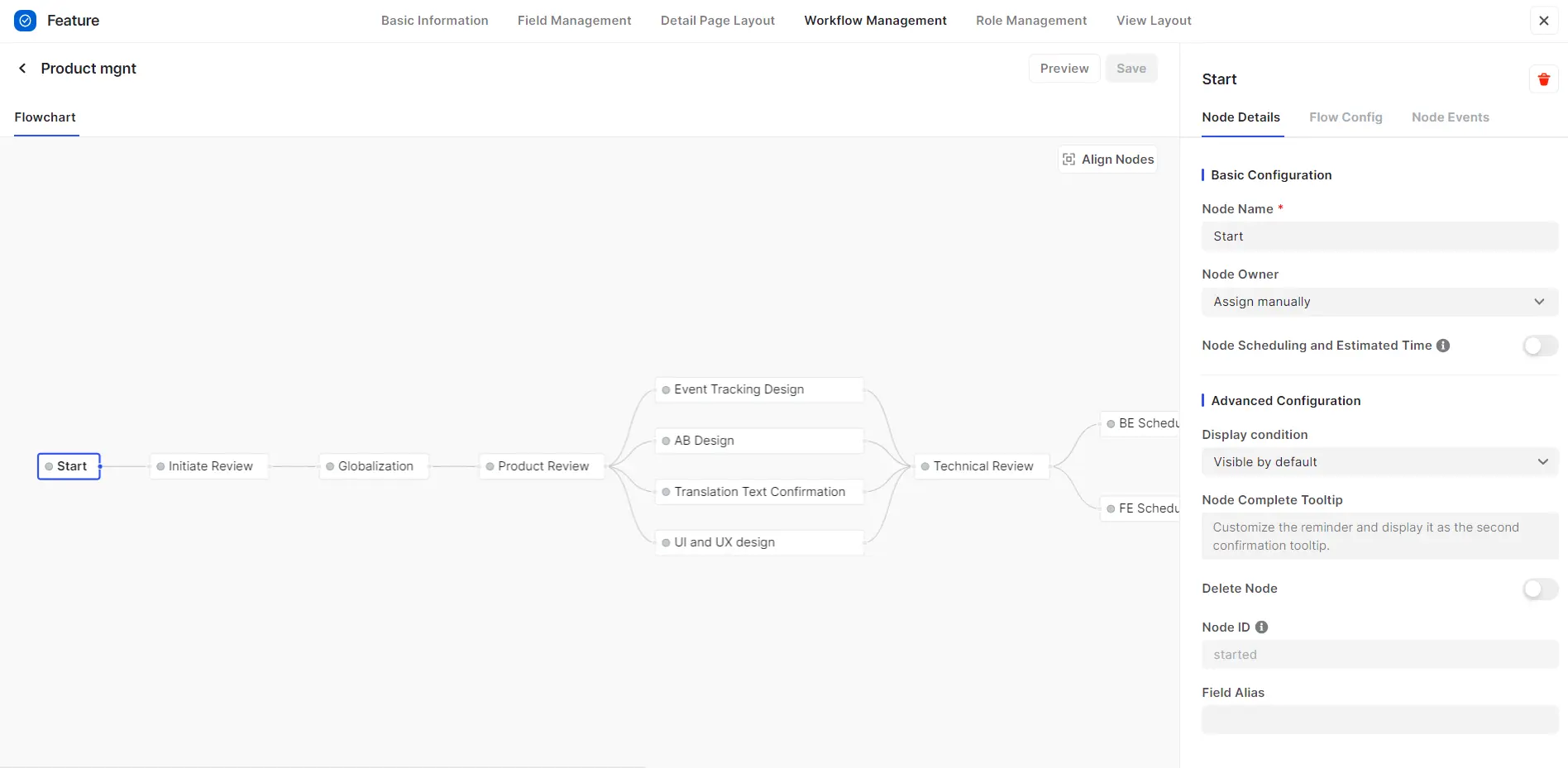 Easy and customizable configuration of workflow in Meegle
Easy and customizable configuration of workflow in MeegleThis differentiation extends beyond unique features to encompass the entire product experience, including:
- Brand identity: The visual and tonal elements that shape perception, like HubSpot’s trusted authority in inbound marketing.
- Distribution channels: The methods through which users access the product, such as Notion's seamless cross-platform synchronization across the web, desktop, and mobile.
Download Meegle's Distribution Channel Strategy Template to achieve project success
- User experience (UX): The interactions that define usability, like Meegle’s customizable visual workflows and rule-based automation for repetitive tasks.
- Customer support: The systems that resolve issues and foster loyalty, as seen in Slack's responsive service with 4.6/5 satisfaction ratings.
Done right, differentiation carves out a market spot that pulls in your dream customers and lets you charge based on your product’s perceived value. Higher the value, higher the price point.
A McKinsey & Company article corroborates this: companies with strong differentiation also see 10-15% higher sales-conversion rates.
What’s more, the perceived value of your product is also the difference between an average tool and one that fosters brand loyalty.
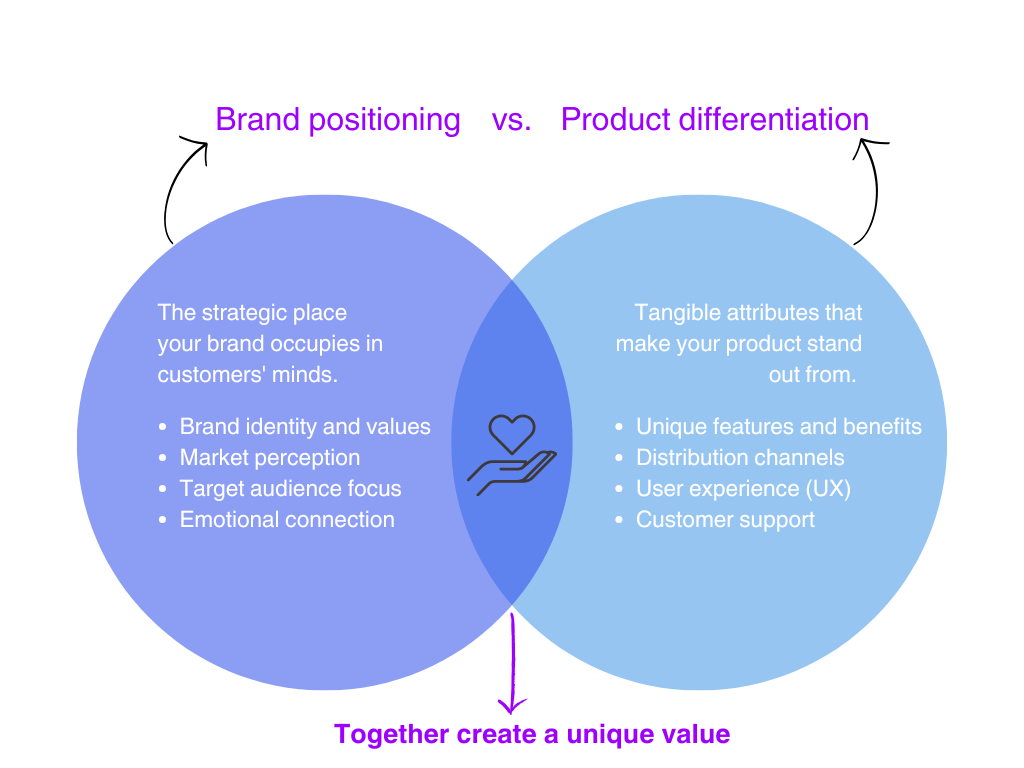 Infographic comparing brand positioning (identity, perception, audience, connection) vs. product differentiation (features, channels, UX, support)
Infographic comparing brand positioning (identity, perception, audience, connection) vs. product differentiation (features, channels, UX, support)However, product differentiation isn’t the same as positioning or branding, though they well play together.
- Positioning is your market claim: where you fit in the landscape.
- Branding is your identity: how you look and sound.
- Differentiation is your actual delivery: what makes using your product genuinely better than alternatives.
It's the tangible experience that proves your positioning and brings your brand to life.
Earlier, it was all about feature wars: more integrations, more checkboxes. But in 2025? It’s the user experience that wins.
Does your tool save time or just add noise? That’s the line.
Suggested read: 👉What is Product Management? | Definition + Resources
Why is product differentiation important?
Product differentiation is important because it creates recognition in a crowded market, drives customer loyalty, justifies premium pricing, and establishes sustainable competitive advantage.
When every product feature blends into the next, relevance comes from being unmistakably useful. According to Forbes, only about 5% of brands are seen as truly unique by customers—which means there’s ample opportunity for product teams to own the narrative.
When your product solves a real, specific problem, customers stay longer, churn drops, and NPS rises. That trust also unlocks pricing power—buyers willingly pay premium rates for solutions that make their lives easier.
In 2025, product differentiation cannot be an afterthought. With a few well-structured prompts, anyone can create product clones in a matter of a few hours. Differentiation must run deeper: flexible workflows that adapt to specific teams, context-rich collaboration, or user experiences that feel tailor-made. For example:
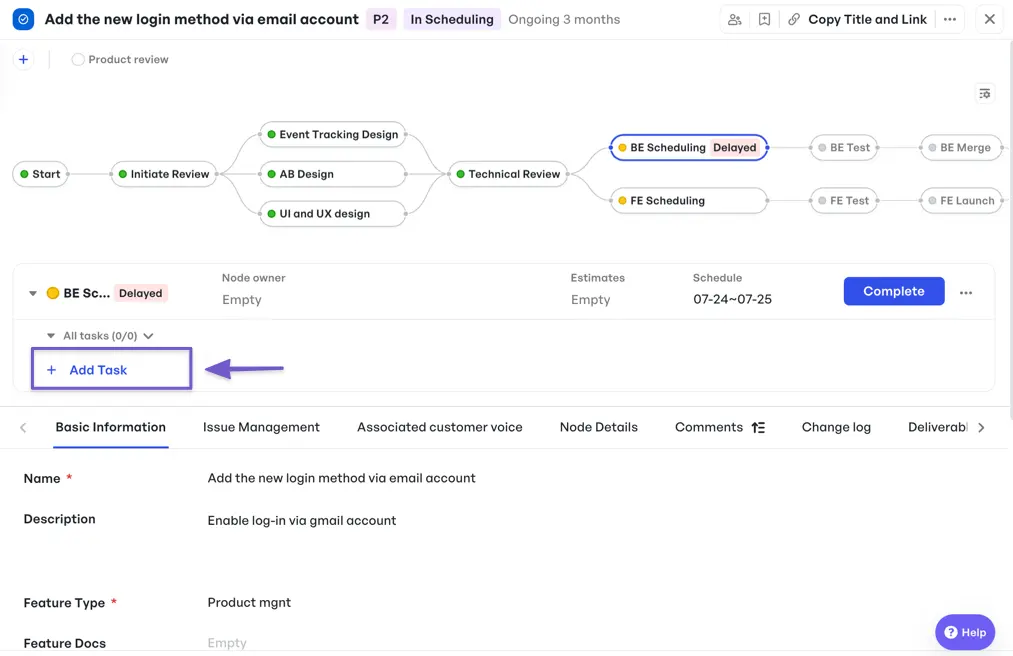 See your tasks, documents, roadmap - all in one place in Meegle
See your tasks, documents, roadmap - all in one place in Meegle- Meegle’s goal-linked planning connects every task, document, and roadmap item to clear business goals, ensuring strategic execution.
- Miro's infinite canvas where spatial relationships preserve context between ideas across departments.
- Canva provides different toolsets and templates based on whether you're creating social media graphics, presentations, or print materials.
Companies that get this right will drive loyalty, sustain higher margins, and shorten the sales cycle.
Related read: 👉11 Essential Product Management Tools to Try in 2025
The psychology behind effective product differentiation
When Zoom entered the video conferencing market in 2011, it faced established giants like WebEx, GoToMeeting, and Skype. Yet within a few years, "Let's hop on Zoom" became the default phrase for video meetings. This transformation—where a brand name becomes the verb for the action itself—represents the ultimate form of product differentiation.
Zoom achieved this by understanding a fundamental psychological truth: users will choose simplicity over feature richness when cognitive load becomes too high. While competitors required downloads, plugins, and complex setups, Zoom differentiated with one-click joining.
This feature reduced cognitive friction at the exact moment users needed to connect. Zoom tapped into user psychological principles that influence how both consumers and businesses evaluate and select products.
A similar principle can be seen with Dyson vacuum cleaners. In a market saturated with cheaper alternatives, Dyson distinguished itself through intuitive usability and sleek, futuristic design. The product didn’t just clean well—it made users feel like they were using superior, effortless technology.
Like Zoom, Dyson succeeded by minimizing complexity and elevating the experience, appealing to both functional needs and emotional triggers.
1. Cognitive biases shape buying decisions
 Illustration showing how bias shapes the brain's decision-making process, influencing customer behavior in marketing. (Source: LinkedIn)
Illustration showing how bias shapes the brain's decision-making process, influencing customer behavior in marketing. (Source: LinkedIn)Product buying decisions, whether by individuals or procurement teams, are shaped by powerful cognitive biases:
- Anchoring affects how value is perceived. When Slack launched, it anchored itself as "email killer," immediately framing its value in relation to a familiar tool while positioning itself as superior. This gave buyers a reference point that made Slack's differences clear.
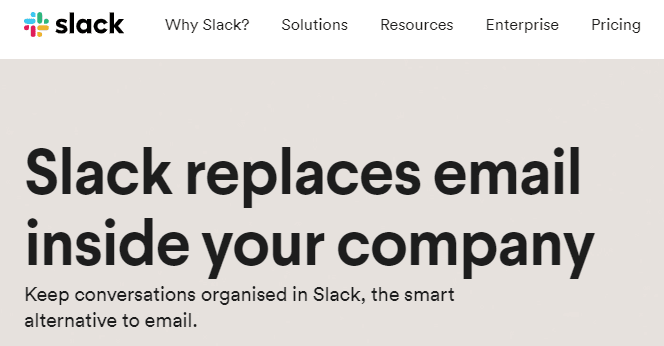 Slack - the email killer (Source: Guild)
Slack - the email killer (Source: Guild)- Loss aversion makes potential losses feel twice as powerful as gains. This core principle from behavioral economics directly shapes buyer decision-making. Notion implements this by emphasizing what users miss with fragmented tools—"stop losing information between apps"—making its all-in-one differentiation resonate more deeply than simply listing features.
- Social proof influences perception through others' experiences. When Figma highlights that "teams at Uber, Airbnb, and Twitter use Figma," it triggers the unconscious thought: "if it works for them, it must be uniquely valuable for us too." This perception shortens evaluation cycles and increases conversion rates as buyers feel confident following established adoption patterns.
2. Balance emotional and rational differentiation
Beyond cognitive biases, effective differentiation requires balancing both rational appeals through features and specifications, alongside emotional connections through identity, belonging, and security.
Look at how Basecamp differentiates. Rationally, through its simplified feature set as "the refreshingly simple project management system", while emotionally connecting through its stance against workplace chaos as "For many, tools like...[sic]...before finally arriving at Basecamp". This combination creates differentiation that appeals to both decision-making systems in our brains.
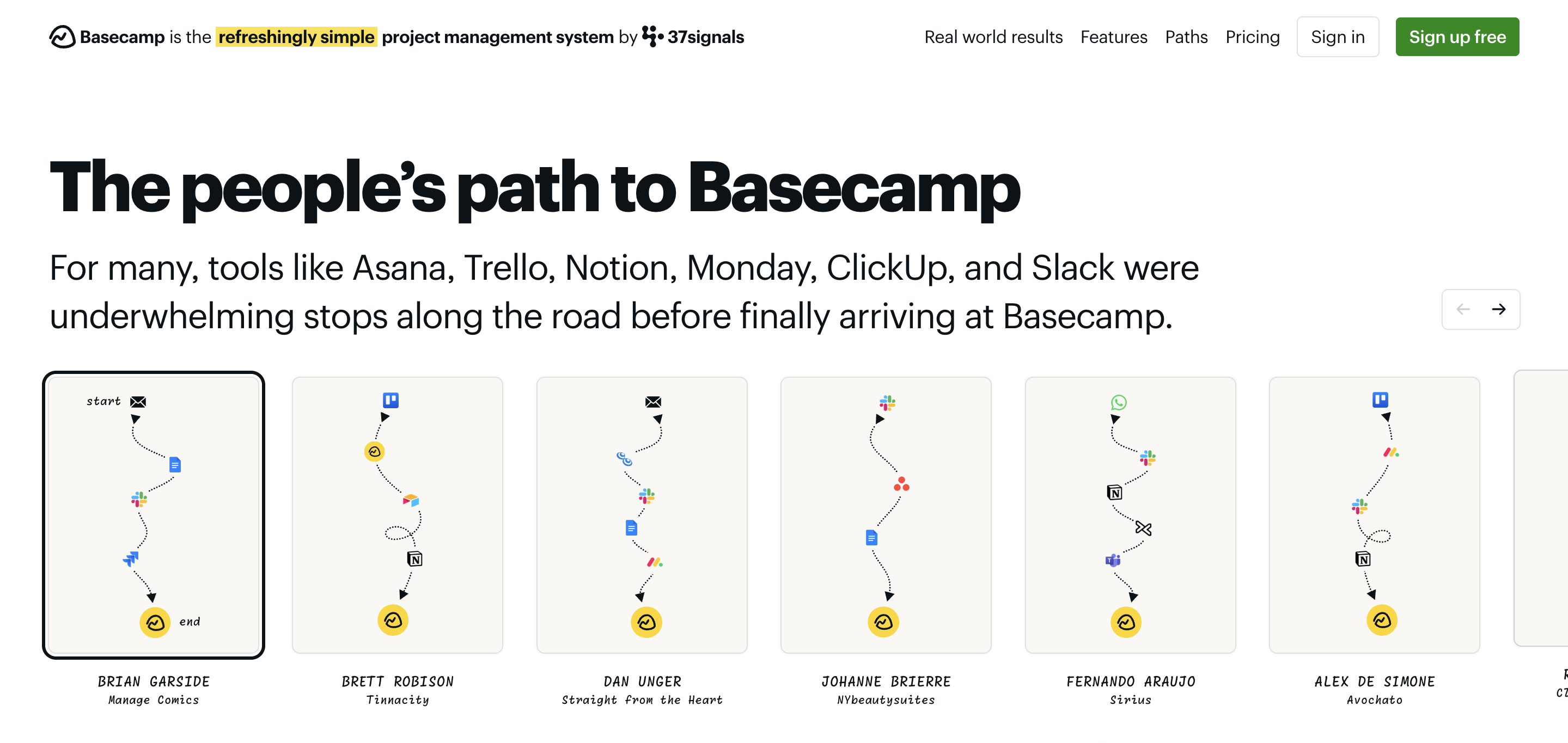 Basecamp - simple project management system (Source: Basecamp)
Basecamp - simple project management system (Source: Basecamp)In 2025's data-saturated environment, emotional differentiation becomes increasingly important. As feature comparison becomes automated through AI tools and comparison platforms, your unique perspective, values, and emotional benefits often determine which products make the shortlist before rational evaluation begins.
3. Reducing decision fatigue
The cognitive load of evaluation creates another opportunity for product differentiation. According to Inbox Insight’s research on the B2B tech buying process, the average B2B buyer now evaluates 5-7 solutions before purchasing. Each tool possesses complex features. Clear differentiation reduces this mental burden.
To stand out in evaluation matrices, focus on creating unique categories that highlight your strengths. When Loom added "async communication score" to comparison charts, they shifted evaluation to territory where they excel, rather than competing on standard metrics. This strategic reframing led to higher win rates in competitive sales situations.
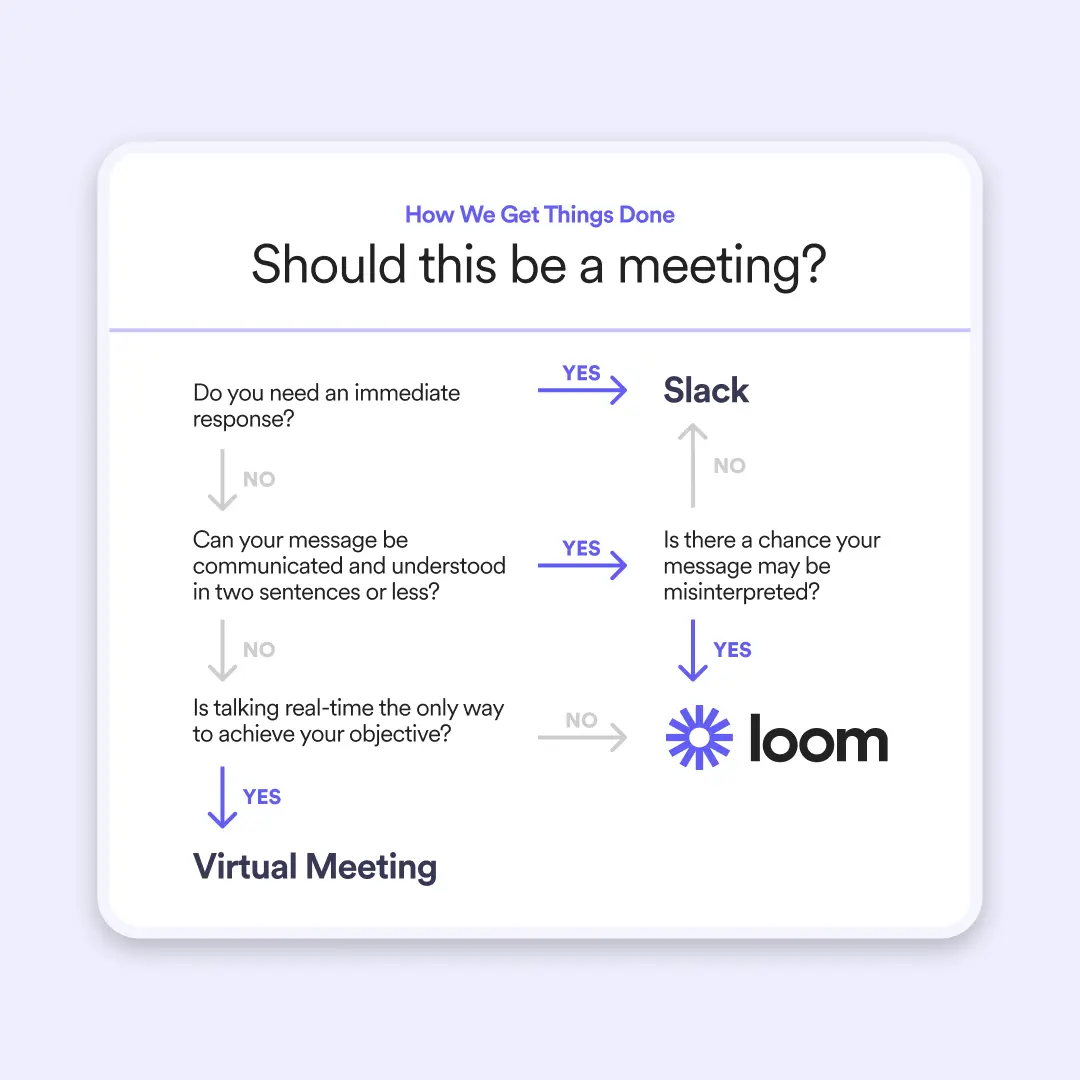 Loom - the async video tool (Source: Loom)
Loom - the async video tool (Source: Loom)The most effective differentiation doesn't just promote your product, it simplifies the buyer's decision-making process by making your unique value immediately clear. As markets grow more crowded, products that create cognitive ease through distinctive positioning will increasingly win against feature-rich alternatives.
Types of product differentiation
Understanding the types of product differentiation can help product managers create standout tools. Here are five approaches to consider in 2025.
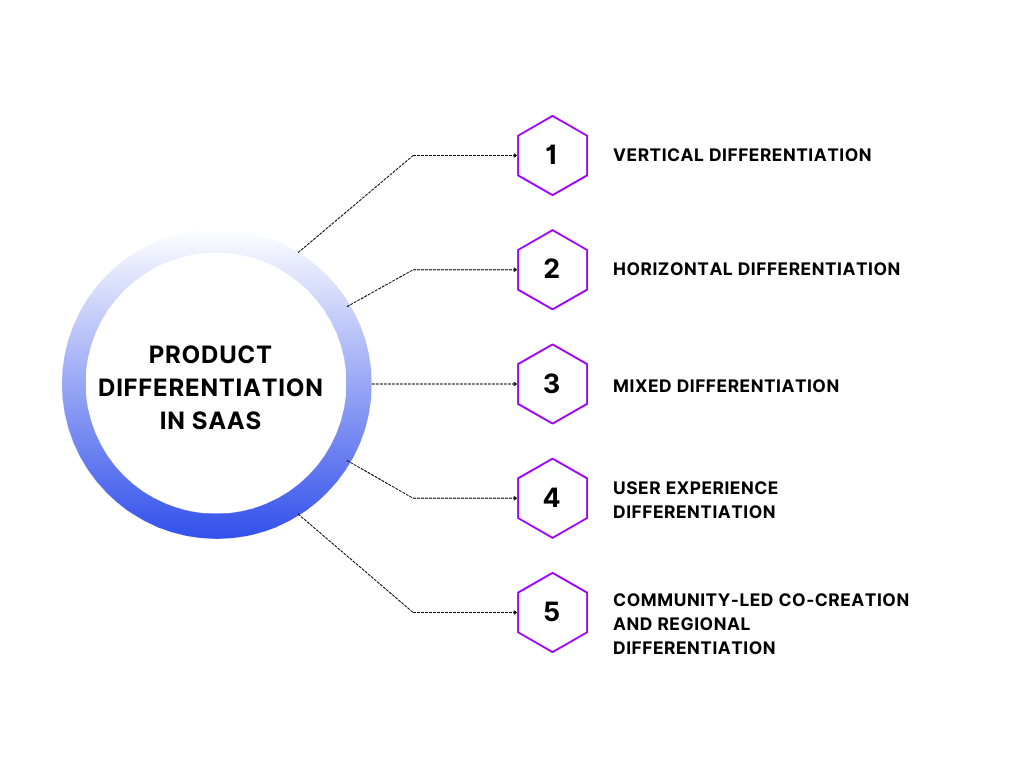 Five types of product differentiation: vertical, horizontal, mixed, user experience, and community-led co-creation with regional differentiation.
Five types of product differentiation: vertical, horizontal, mixed, user experience, and community-led co-creation with regional differentiation.1. Vertical differentiation
Vertical product differentiation is based on measurable factors like price, performance, security, or the depth of features. It often shows up as tiered offerings—where one product version is positioned as a more advanced or premium alternative to a basic or budget-friendly option.
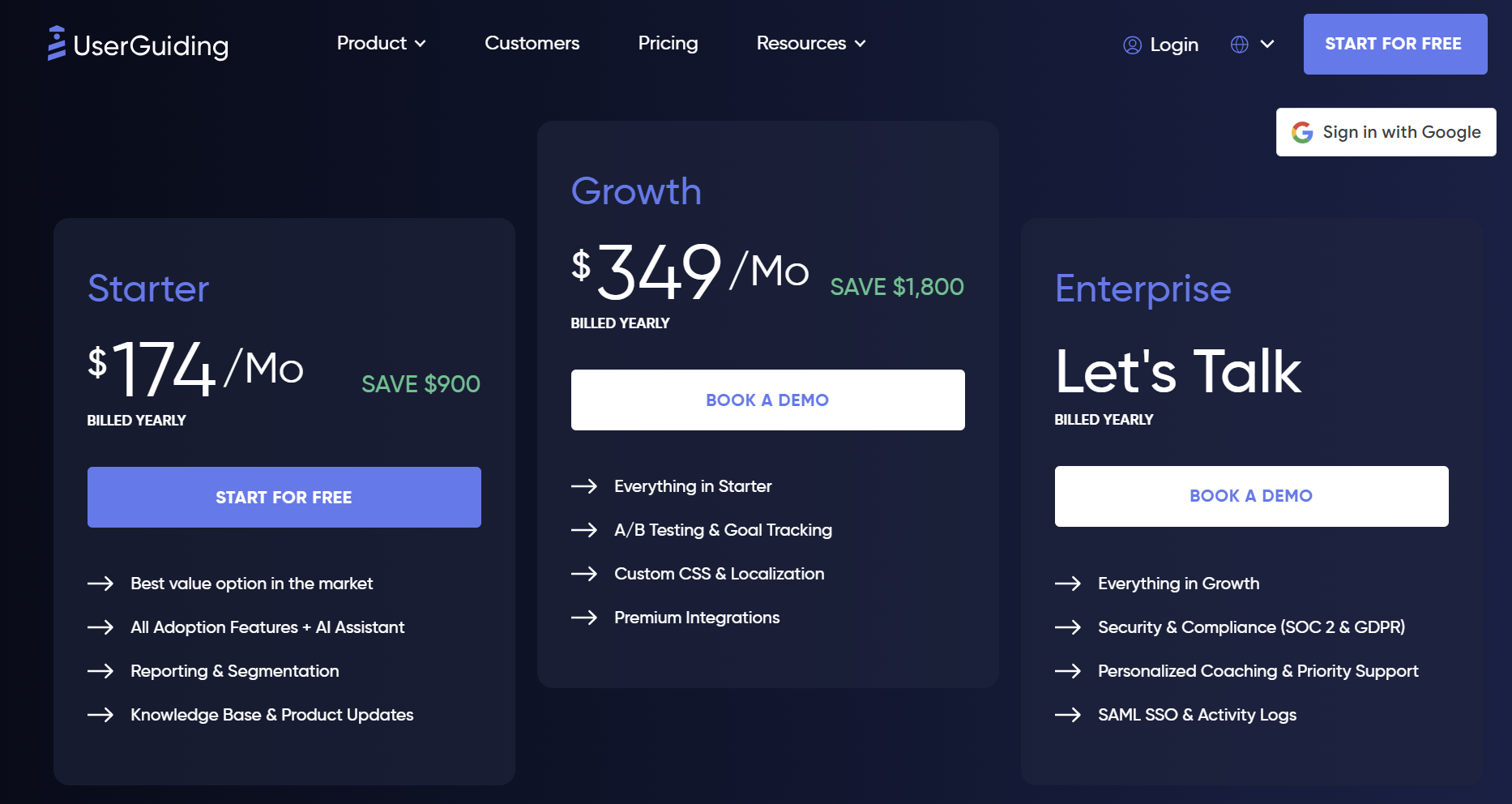 UserGuiding pricing (Source: UserGuiding)
UserGuiding pricing (Source: UserGuiding)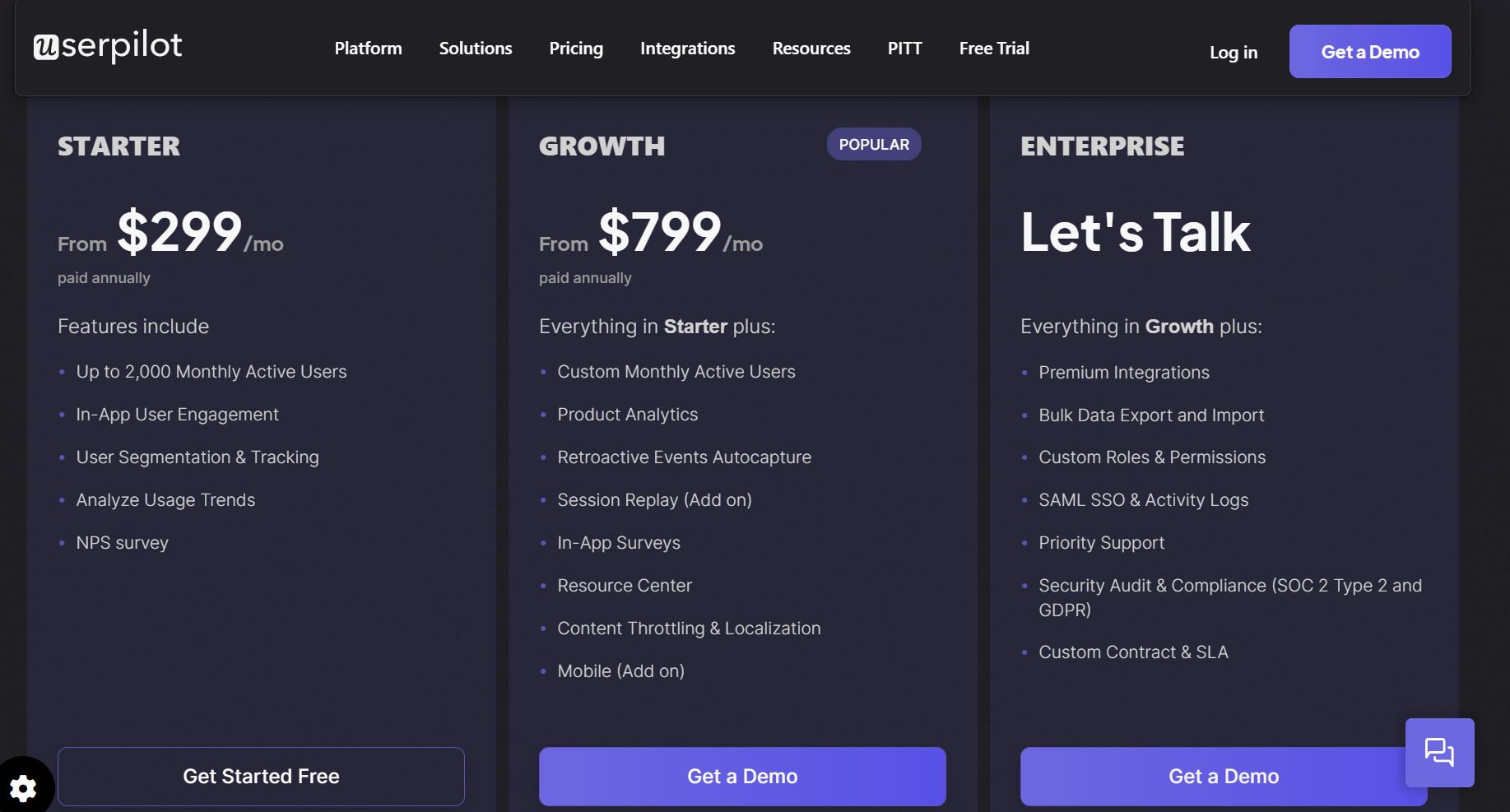 Userpilot Pricing (Source: Userpilot)
Userpilot Pricing (Source: Userpilot)For example, UserGuiding appeals to cost-conscious teams with affordable pricing, while Userpilot justifies a higher price through a richer feature suite.
When to use vertical product differentiation
Choose vertical differentiation if your target market values measurable improvements like faster performance, tighter security, or advanced capabilities and is willing to pay for them. This approach is ideal for mature markets where buyers make direct comparisons and seek the "best" based on tangible criteria.
2. Horizontal differentiation
Horizontal product differentiation occurs when multiple tools offer similar levels of core functionality, but purchasing decisions are influenced by user-specific preferences such as interface familiarity, workflow compatibility, or brand perception.
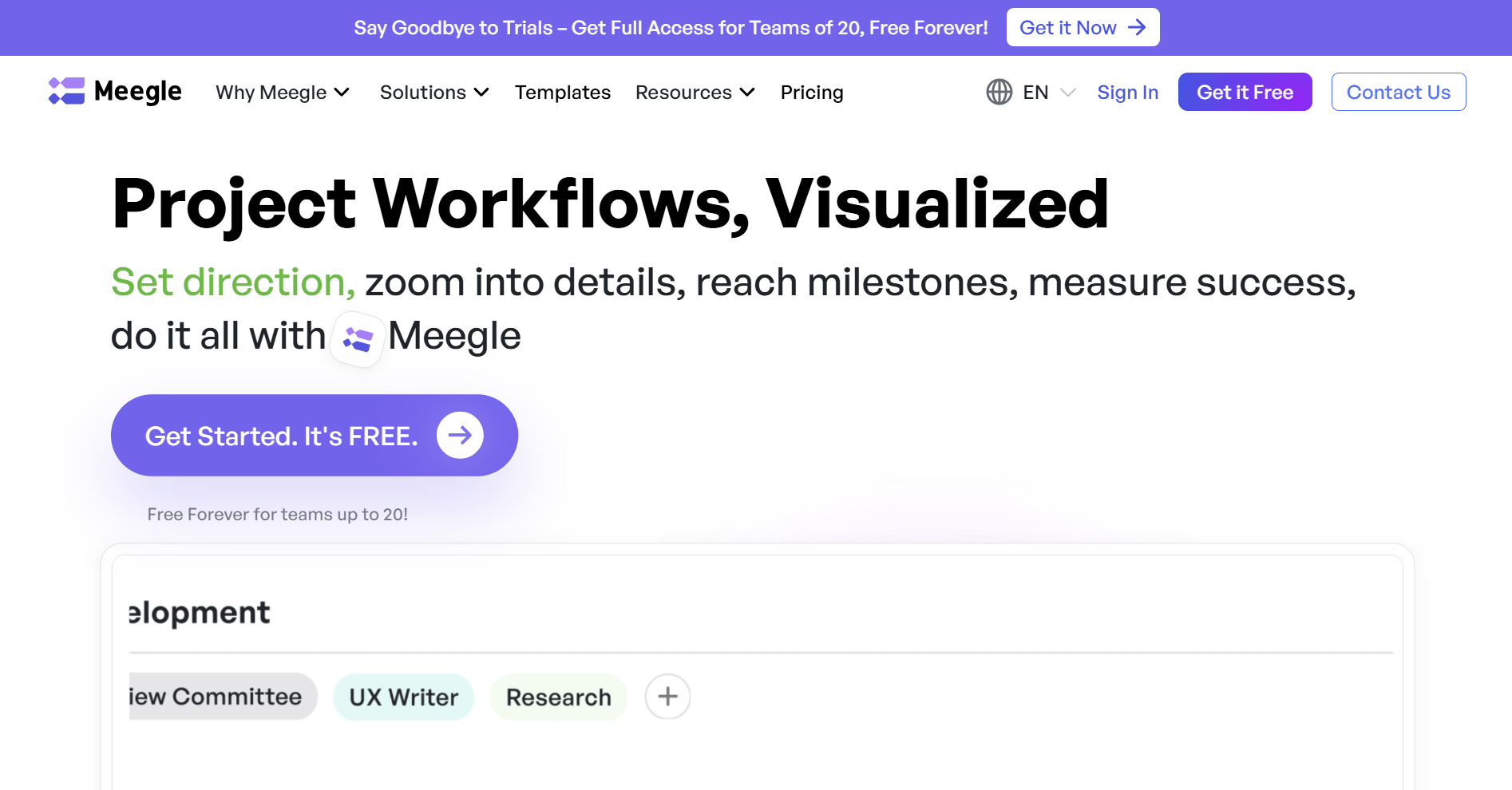 Meegle for all your project and product management needs
Meegle for all your project and product management needs ClickUp (Source: ClickUp)
ClickUp (Source: ClickUp)For instance, both Meegle and ClickUp provide end-to-end tools for managing tasks, projects, and team collaboration. But their differentiation lies in how they guide execution and structure decision-making. Meegle is designed specifically for product and marketing leaders who need flexibility along with structured decision-making frameworks, live collaborative documents, and pre-built strategic templates (like product briefs, marketing plans, and GTM checklists) that reduce ambiguity and accelerate alignment across teams.
ClickUp prioritizes extreme customization and broad applicability across roles—from developers to HR—leaving much of the process setup to individual teams. For fast-moving orgs that want speed with structure, Meegle becomes the better choice: fewer decisions about how to work, and more focus on what to build next.
When to use horizontal product differentiation
Use horizontal differentiation to attract users with specific workflows or preferences, especially in crowded categories where core features have become commoditized. Look for opportunities in underserved verticals, UX/UI expectations, or niche customer segments.
3. Mixed differentiation
Mixed product differentiation blends objective value with emotional appeal. This could mean combining enterprise-grade compliance and performance (rational differentiators) with an intuitive, visually pleasing, and industry-specific interface (emotional differentiators). This approach appeals to both the logical and emotional sides of the buyer’s decision-making process.
For example, Starbucks has built strong brand loyalty by offering a distinctive experience that blends reliable product quality and customization (rational appeal) with a welcoming atmosphere and lifestyle branding (emotional appeal).
When to use mixed product differentiation
Utilize mixed differentiation when your buyers expect both technical excellence and a frictionless, personalized experience. This approach works especially well with sophisticated customers who evaluate tools on multiple levels.
4. User experience differentiation
UX (User Experience) differentiation is about making your product easier, faster, or more enjoyable to use. This includes intuitive UI, frictionless onboarding, and workflows that reduce user effort.
Meegle differentiates itself through an intuitive UI, minimal training requirement, and visual workflows, which directly appeal to:
- Fast-paced teams who can’t afford a steep learning curve
- Project managers looking for a clean, functional interface
- SMBs that want powerful tools without enterprise complexity
Meegle's intuitive UI, minimal training, and visual workflows make it an ideal choice for SMBs and fast teams.
When to use user experience differentiation
Use UX differentiation when your market is saturated with similar products, and ease of use becomes a key decision factor. It’s particularly effective for time-strapped users who want faster value and personalized interactions.
5. Emerging types for 2025
As markets mature and feature parity rises, the next frontiers of differentiation will come from how you involve and localize around your users—rather than just what you build.
Community-led growth and co-creation
Most brands are increasingly tapping into their own customer base for ideas and feedback. For example, Buffer invites users to suggest and vote on new features via their public roadmap and suggestions board, turning customers into co-creators and being in-tune to user’s preferences.
Regional differentiation
Tailoring your product experience through language localization, compliance support, or integration with local platforms can help brands move into new markets. Zendesk, for instance, offers region-specific data hosting and local-language help centers to meet both regulatory requirements and customer expectations around the world.
4-step product differentiation playbook for 2025
Before you can carve out a unique position, you need a clear line of sight into what your users truly need and what your competitors are missing. This section breaks down the process into four actionable steps, each designed to use raw insights into powerful, hard-to-replicate advantages. We'll also explore how Meegle's feature set makes implementing this differentiation playbook intuitive, easy, and measurable.
Step 1: Understand the problem, the market and your competitors
Begin by digging into user pain points. Run brief, focused surveys that ask open-ended questions like “What’s slowing you down today?” and not “Which feature do you want?”
- Connect surveys and analytics tools via Meegle’s versatile Integrations, then funnel all responses into your differentiation swimlane. Your workspace becomes a living dashboard of insights, not scattered spreadsheets.
 Meegle can integrate with popular tools: Slack, Zapier, GitHub, GitLab, and custom apps.
Meegle can integrate with popular tools: Slack, Zapier, GitHub, GitLab, and custom apps.- Follow up with 30-minute interviews to capture the exact language your users use when describing their challenges.
- Next, pair these qualitative insights with product analytics to spot drop-off points where customers abandon a flow or feature. These data-backed blind spots can put a spotlight on unmet needs, beyond your current roadmap.
- Bring together product, marketing, sales and support in a two-hour differentiation workshop. Split into small groups to list top user pain points, competitor gaps and bold “what-if” ideas. Vote to identify the three highest-impact areas where your product can outpace the rest.
Stakeholders can use Meegle's voting feature to brainstorm and take important product-related decisions.
- Frame discovery around the outcomes customers seek—“When I need to onboard a new team member in under an hour, what stands in my way?” This shifts focus from feature wish-lists to real business jobs, uncovering unique angles for differentiation.
By combining direct user conversations, data-driven analysis, stakeholder workshops, and JTBD insights, you’ll surface the most compelling opportunities for your product positioning.
Step 2: Identify and prioritize differentiators
Once you've mapped the landscape, it's time to pinpoint exactly where and how you'll stand apart. Start by creating a comprehensive list of possible differentiators across categories:
- Core features: What capabilities could you uniquely deliver?
- User experience: Where could your interface or workflows feel distinctly better?
- Pricing model: Is there an innovative approach to value exchange?
- Performance metrics: Speed, reliability, or scale advantages?
- Integration ecosystem: Connections that solve specific workflow gaps?
Next, build a simple differentiation canvas that maps each potential differentiator against two axes: "importance to target users" and "our ability to execute uniquely well." This visual exercise quickly surfaces opportunities where customer needs align with your teams’ distinctive capabilities.
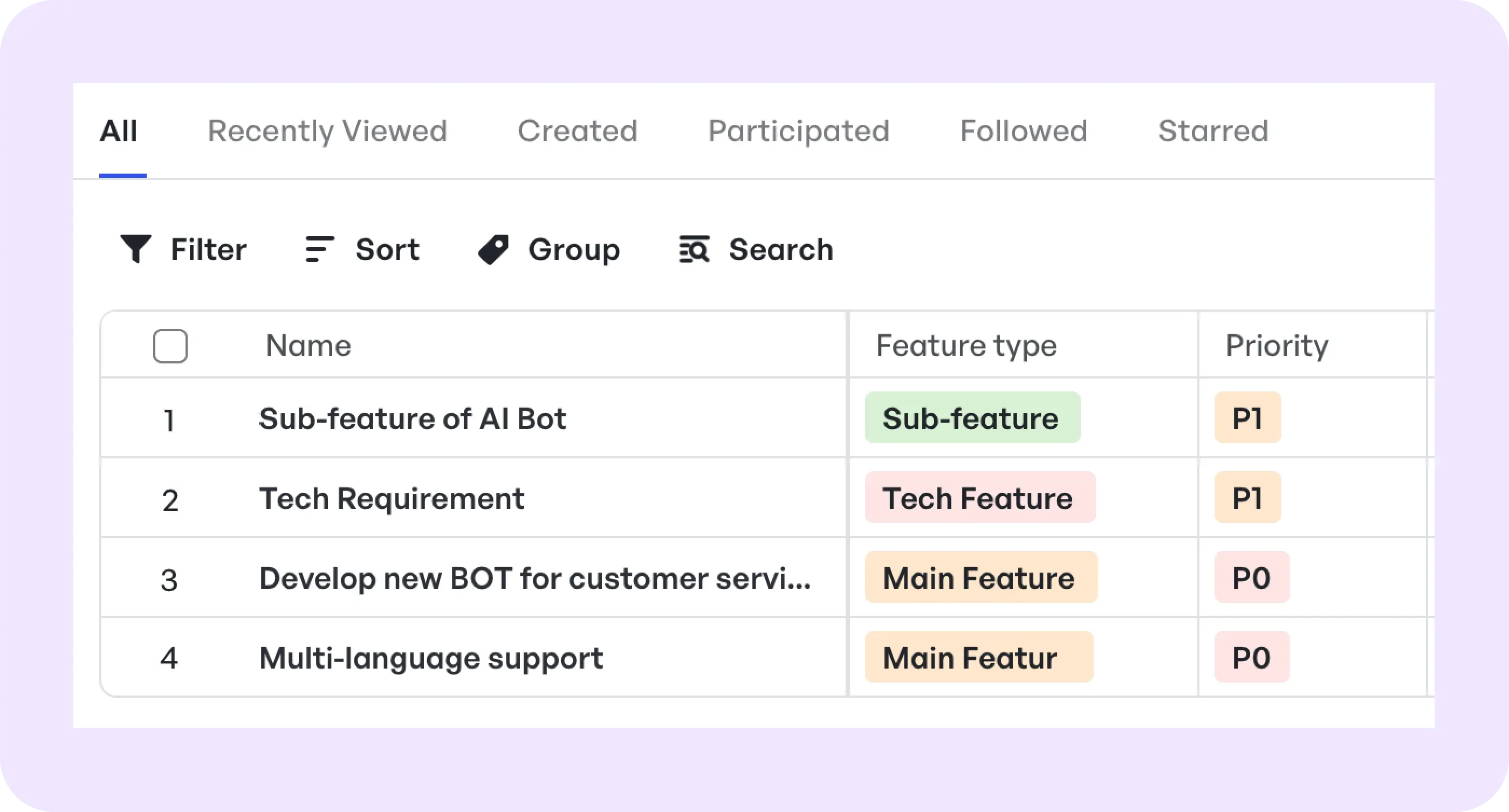 Feature backlog with prioritization on Meegle: tasks categorized by feature type and priority level for sprint planning.
Feature backlog with prioritization on Meegle: tasks categorized by feature type and priority level for sprint planning.When prioritizing, avoid the trap of consensus-driven mediocrity. Instead, use a modified Kano model to categorize potential differentiators:
- Must-haves: Features your product needs to compete
- Performance differentiators: Areas where "better" directly translates to value
- Delighters: Unexpected elements that create emotional connection
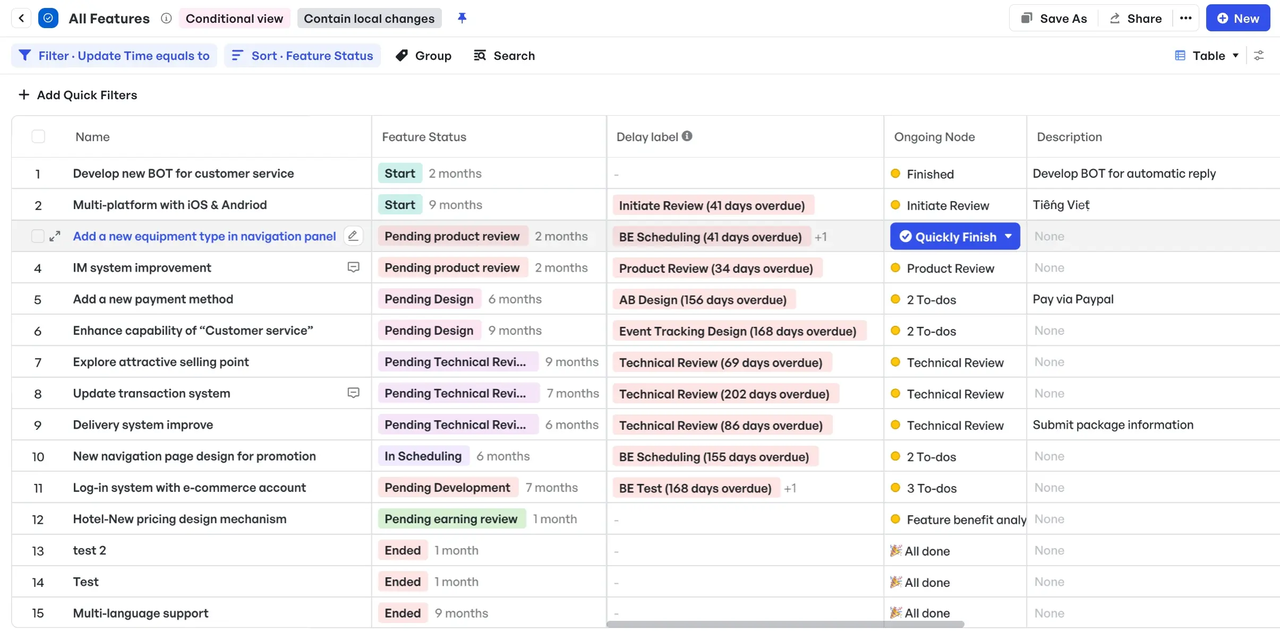 Table View in Meegle
Table View in MeegleThe most effective product differentiators often combine performance differentiators with delighters, Meegle’s structured product planning workflows (performance) paired with contextual decision logs and subtle UX touches like Table View, Kanban, Gantt Charts, etc., that reduce cognitive load (delighters).
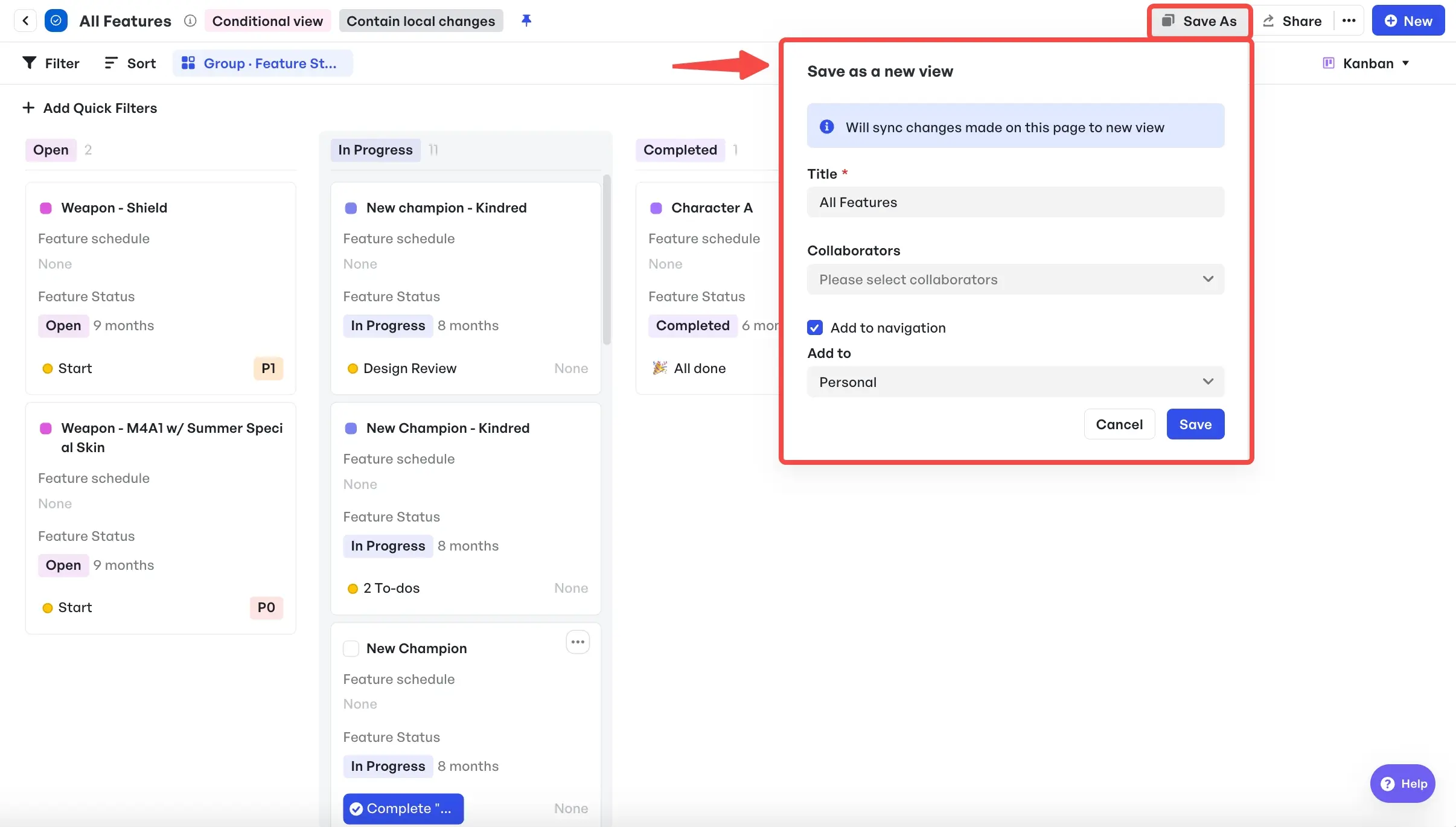 Kanban View in Meegle
Kanban View in MeegleBefore finalizing your differentiation strategy, run a cross-functional alignment workshop. Have each department answer: "How will this differentiation approach affect your area?" and "What would you need to deliver on this promise?" This surfaces potential execution challenges and builds the shared commitment needed for authentic differentiation.
Step 3: Execution and alignment
With your differentiators identified and prioritized, it’s time to implement the strategy into market advantages. This phase is where many differentiation efforts falter. Turning market insights into coordinated action requires both structure and flexibility.
Meegle’s customizable workflows and pre-built templates can make roadmap management and product development an intuitive process.
Related read: 👉8 Stages of the New Product Development Process
1. Mapping differentiators to the roadmap
Start by explicitly mapping differentiators to your product roadmap. Create dedicated initiatives that highlight these strategic elements separate from routine development. For each differentiator:
- Define clear success metrics (e.g., "reduce onboarding time by 45%")
- Establish baseline measurements to track improvement
- Set milestone dates that align with market opportunities
- Identify dependencies across product components
Views allow you to visualize these initiatives, track progress, and adjust timelines in real-time, ensuring your differentiators remain prioritized.
 Meegle's views displaying the roadmap of a transaction platform, with visual task mapping and timeline tracking to prioritize key initiatives in real-time.
Meegle's views displaying the roadmap of a transaction platform, with visual task mapping and timeline tracking to prioritize key initiatives in real-time.2. Aligning cross-functional teams
Next, align cross-functional teams around your differentiation strategy through structured communication:
- Development needs detailed specs that preserve what makes features truly distinctive.
- Marketing requires advance notice to develop messaging that highlights unique advantages.
- Sales teams must understand exactly how these differentiators solve customer problems.
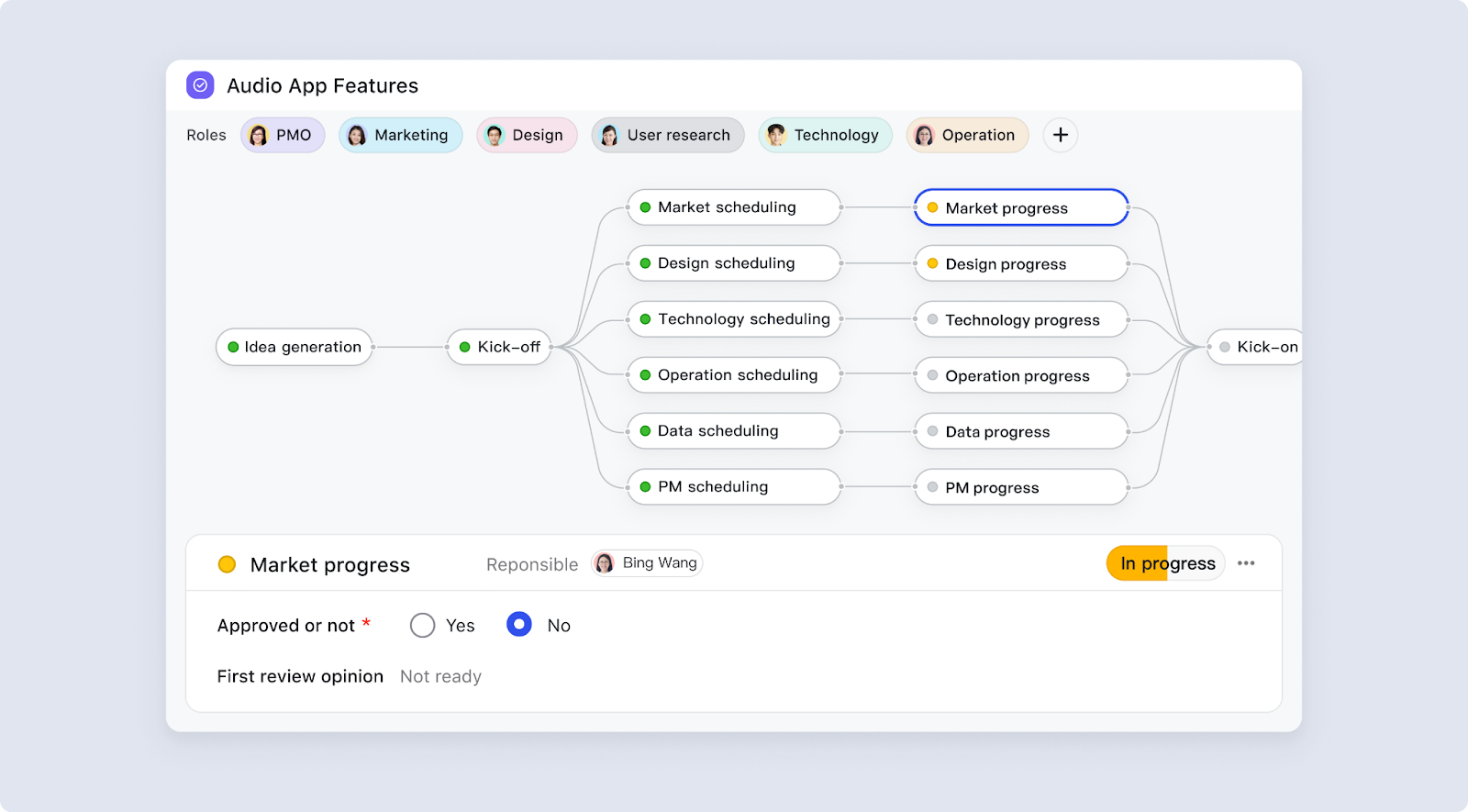 Meegle dashboard gives product managers real-time visibility into how cross-functional teams are progressing, so everyone stays aligned without manual updates.
Meegle dashboard gives product managers real-time visibility into how cross-functional teams are progressing, so everyone stays aligned without manual updates.Keeping these diverse teams synchronized traditionally requires endless meetings and email chains. Meegle's dashboard offers real-time progress monitoring, eliminating this friction by giving product teams instant visibility into how differentiation initiatives are advancing.
Instead of hunting for updates or waiting for weekly status reports, product managers can see which elements are on track and which need attention right from their dashboard.
3. Managing specialized workflows
Establish specialized workflows for managing differentiation initiatives. Unlike standard feature development, differentiation often requires:
- Additional validation steps to confirm uniqueness
- User testing focused on perceived differentiation
- Competitive analysis checkpoints throughout development
- Specialized QA that verifies the differentiating elements work as intended
These unique requirements demand flexibility that rigid development processes can't provide. Meegle's intuitive workflow makes these complex differentiation processes simple by laying out every task and milestone in a clear, visual sequence. Instead of losing track of critical differentiation checkpoints, teams can see the entire journey mapped out.
 Meegle workflow configuration interface showing customizable process steps with node setup options for varied checkpoints in product development.
Meegle workflow configuration interface showing customizable process steps with node setup options for varied checkpoints in product development.The platform eliminates handoff friction between teams. When product designers complete their work, engineering is automatically notified, and when development finishes, QA immediately knows to begin validation focused on differentiating features.
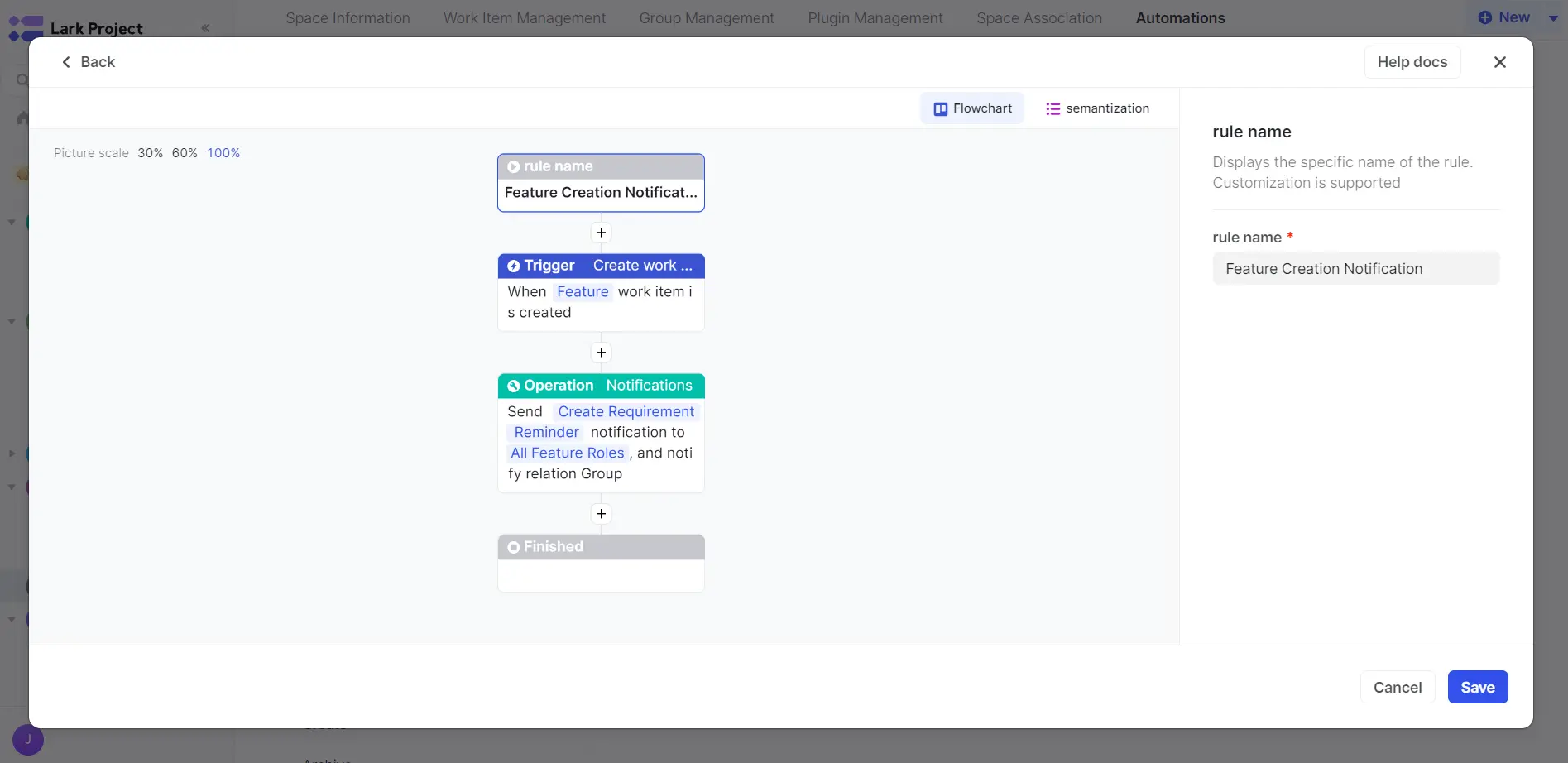 Meegle automation rules set triggers wherein when a task is completed, the right teams are instantly notified, so nothing slips through the cracks.
Meegle automation rules set triggers wherein when a task is completed, the right teams are instantly notified, so nothing slips through the cracks.When market conditions change or competitors make unexpected moves, workflows can be adjusted with a single click, allowing teams to pivot quickly while preserving what makes your product stand out.
4. Adapting to development methodologies
Different development methodologies require tailored approaches to managing differentiation work:
- Agile teams can designate "differentiation stories" with special tracking.
- Waterfall processes benefit from dedicated differentiation reviews at each stage gate.
- Hybrid models might use separate tracks for standard features vs. differentiation elements.
While most tools force you to adapt to their workflow, Meegle's flexible approach works the other way around. The platform offers built-in templates that can be quickly customized to match your specific approach.
This flexibility ensures your differentiation initiatives receive proper attention without disrupting established team rhythms.
- Agile teams can integrate differentiation-focused user stories into sprints while maintaining special visibility.
 Meegle workflow interface showing Epic > Story > Plan > Task hierarchy alongside Q3 Milestones tracking view with filtered items organized by completion status.
Meegle workflow interface showing Epic > Story > Plan > Task hierarchy alongside Q3 Milestones tracking view with filtered items organized by completion status.- Waterfall teams can embed differentiation checkpoints at critical stage gates.
- Hybrid teams can create parallel tracks that give differentiation elements the unique treatment they require.
By adapting to your preferred project management methodology rather than imposing a new one, Meegle helps teams maintain focus on differentiation while still meeting product deadlines. The result: your unique product elements make it through development intact, preserving the market advantages you've worked so hard to create.
Step 4: Iteration and evolution
Even the most carefully crafted differentiation strategy needs continuous refinement. Markets shift, competitors respond, and customer expectations evolve rapidly. The difference between products that maintain their unique edge and those that fade into sameness often comes down to structured iteration.
1. Creating feedback loops that drive real value
Start by establishing systematic ways to evaluate your differentiation effectiveness:
- Customer interviews specifically focused on unique value perception
- Usage analytics that track engagement with differentiating features
- Competitor response monitoring to detect attempts to close the gap
 Meegle's dashboard provides a single space where teams can collect customer feedback, and stakeholders can vote on product improvements.
Meegle's dashboard provides a single space where teams can collect customer feedback, and stakeholders can vote on product improvements.The most successful teams combine these insights in a central location where patterns can emerge. Meegle makes this process seamless by connecting feedback from multiple channels directly to your differentiation initiatives. This creates a continuous learning cycle where customer comments, usage metrics, and team observations inform your next moves.
2. Recognizing pivot signals early
Watch for these warning signs that suggest your differentiation approach needs adjustment:
- Differentiating features see low adoption despite awareness
- Competitors successfully replicate your unique elements
- Customer feedback indicates value perception doesn't match your strategy
- Market conditions change, making your differentiators less relevant
When you spot these signals, don't hesitate to pivot. Quick adjustments maintain your market advantage more effectively than persisting with a fading strategy.
Meegle's work progress plugin reshapes how product teams tackle their daily grind, turning chaos into clarity and saving time for what really matters.
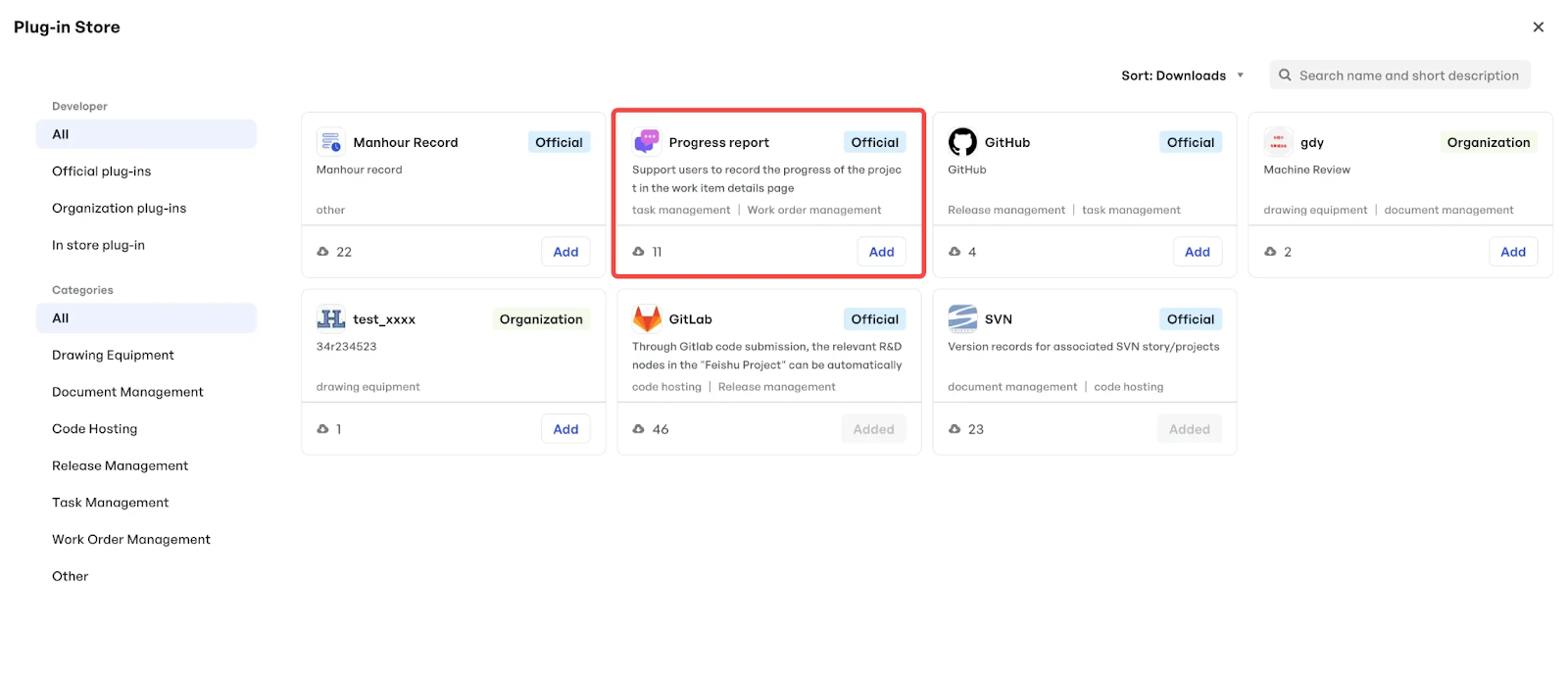 Meegle's plugin store showing the Progress Report plugin, which helps teams track project progress within work item detail pages.
Meegle's plugin store showing the Progress Report plugin, which helps teams track project progress within work item detail pages.Instead of waking up to an inbox stuffed with disjointed status emails or spending half the morning chasing down updates from developers, designers, and marketers, a product manager logs in and sees everything: from feature adoption stats, customer feedback, to competitor moves, all in one centralized, real-time hub.
No more digging through Slack threads or waiting for a lagging spreadsheet to load.
 Meegle's Progress Report interface showing a status update form with rich text formatting and status tracking fields for team communication.
Meegle's Progress Report interface showing a status update form with rich text formatting and status tracking fields for team communication.With automated notifications, you can spot issues before they become blockers. Based on your team's bandwidth, you can brainstorm a fix without having to change the roadmap.
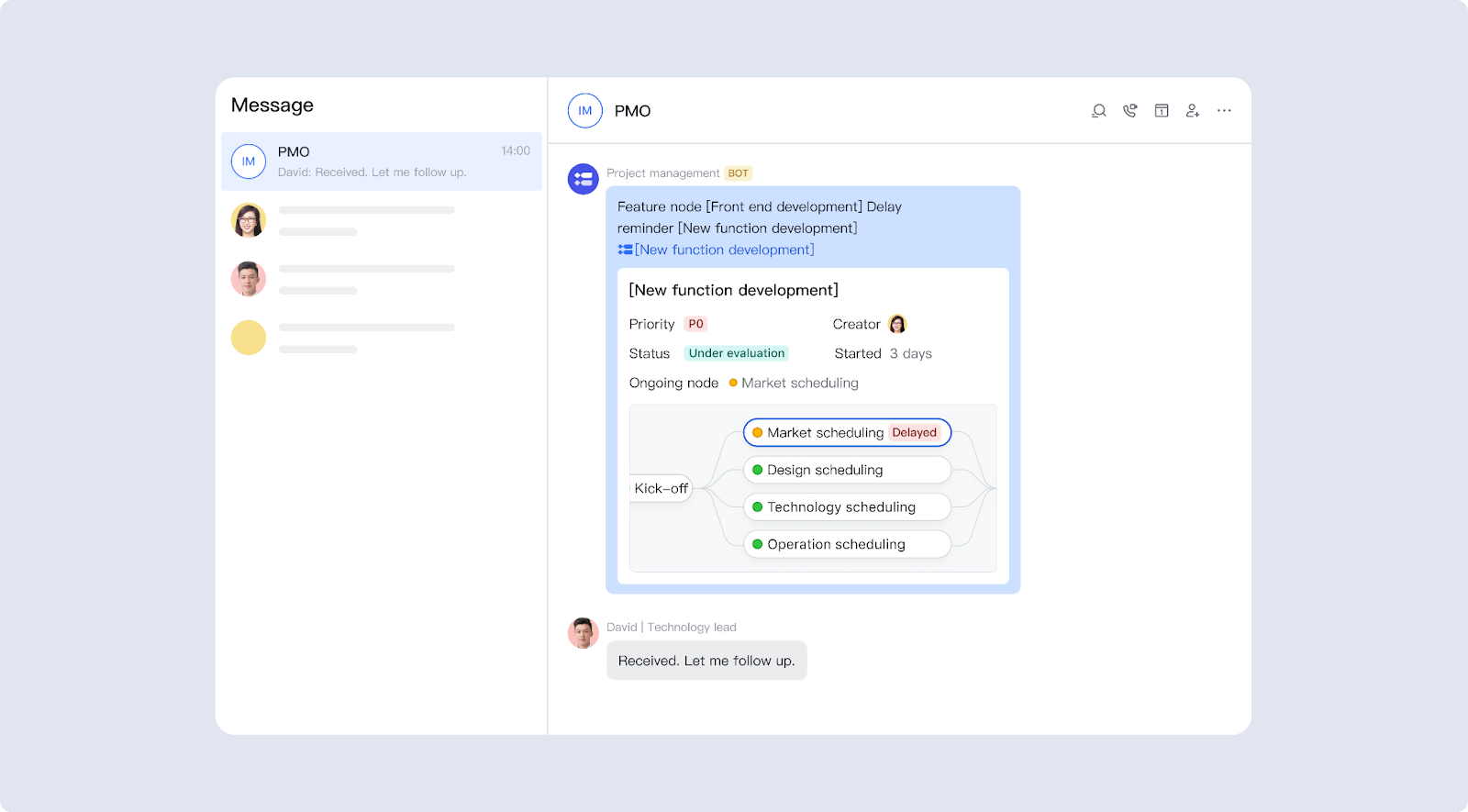 Meegle's inbox showing an automated project notification regarding task delays, including a visual workflow with current status and related tasks.
Meegle's inbox showing an automated project notification regarding task delays, including a visual workflow with current status and related tasks.Team members can change task status on the fly, so everyone's on the same page without the dreaded "where are we at?" meeting. Let's say a developer tweaks a feature overnight; the product manager sees it first thing, shares feedback, and adjusts the plan—all before your morning coffee gets cold.
Moreover, you can integrate your Slack with Meegle.
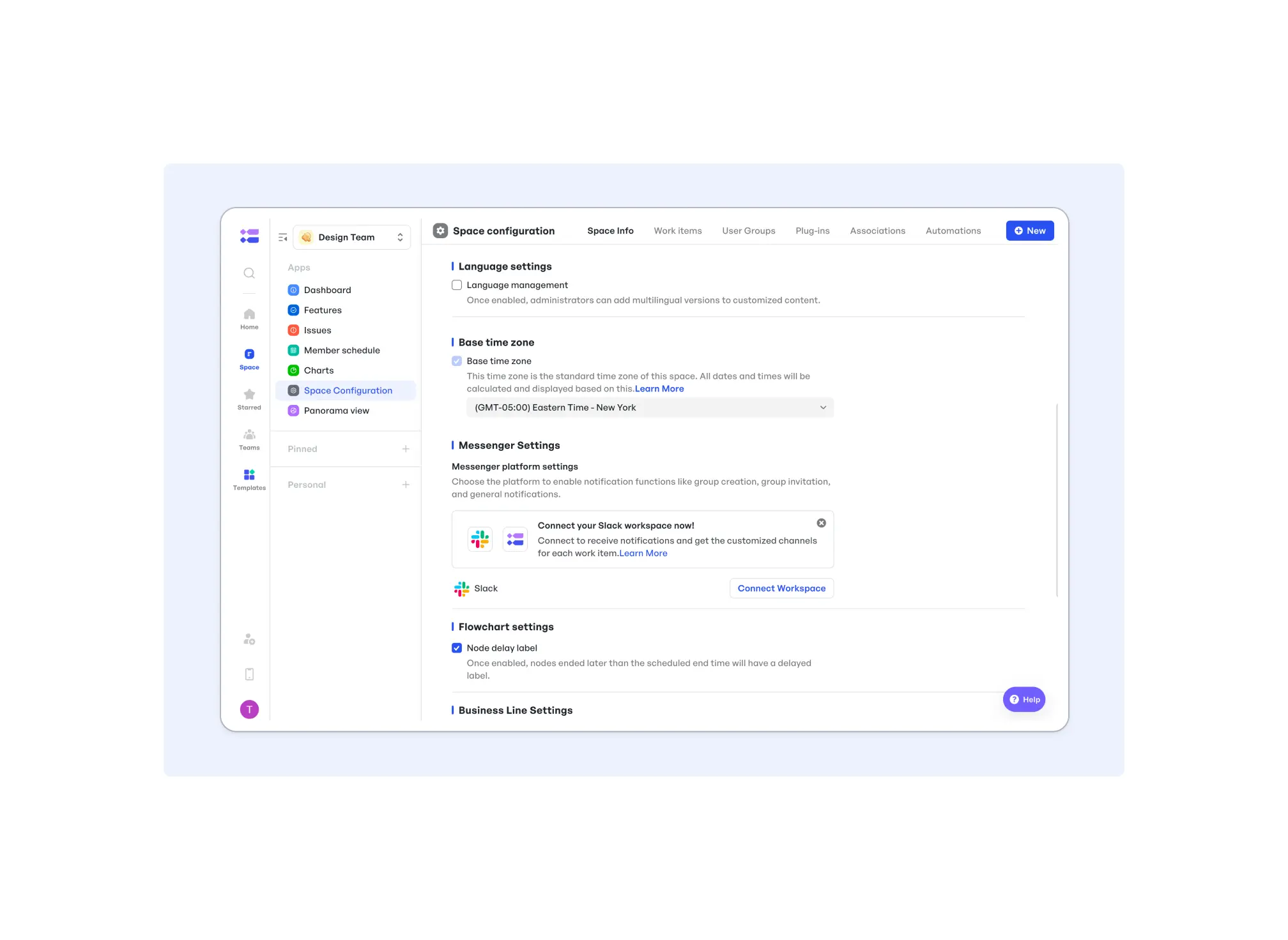 Meegle's integration with Slack
Meegle's integration with SlackThat flexibility, paired with transparent collaboration, means less time wrangling updates and more time refining what makes the product stand out.
Less manual busywork means fewer late nights piecing together reports, giving team members breathing room to think creatively or even sign off on time.
3. Making data-driven differentiation decisions
Data should drive your differentiation evolution. Focus on metrics that reveal true performance:
- Engagement rates with differentiating features vs. standard features
- Correlation between differentiated elements and retention
- Feature-specific NPS to measure perceived value
Real-time progress monitoring is essential during these critical decision points. From Meegle's My Work dashboard, product teams can instantly track the status of differentiation initiatives across multiple workspaces. This visibility helps teams identify trends, spot potential issues, and make data-driven adjustments before market advantages erode.
 My Work dashboard in Meegle showing feature tracking, status updates, and schedules across multiple product workspaces.
My Work dashboard in Meegle showing feature tracking, status updates, and schedules across multiple product workspaces.4. Fostering a differentiation-focused culture
The most consistently differentiated products come from teams where unique value creation becomes part of the culture. Foster this mindset by:
- Celebrating differentiation wins visibly across the organization
- Sharing customer stories that highlight differentiation impact
- Including differentiation measures in performance evaluations
By establishing structured feedback systems, recognizing pivot signals early, leveraging analytics, and nurturing a differentiation culture, your product will maintain its unique market position even as conditions change around you.
The key is building a system where adaptation happens continuously rather than reactively, ensuring your differentiators remain relevant in an ever-evolving marketplace.
How to measure the effectiveness of product differentiation?
To know if your differentiation strategy is working, you need clear, actionable metrics that reveal how your unique features impact user perception, competitive standing, and engagement.
1. Core performance metrics
These metrics reveal how well your differentiation resonates with users and drives satisfaction:
- Perception score: Use surveys to ask users about your product’s unique value (e.g., “What sets us apart from competitors?”). Track sentiment through social listening tools to gauge perception over time.
- Feature adoption and usage rates: Monitor how quickly users adopt and engage with your differentiated features. High adoption signals strong differentiation; low adoption may indicate a need for refinement.
- NPS, CSAT, and churn delta: Segment these metrics by users who engage with your unique features. A higher NPS or lower churn among these users suggests effective differentiation.
Related read:
Discover the essential KPIs every product manager should track from adoption and retention rates to feature engagement and revenue impact. Get actionable tips for setting targets, visualizing progress, and aligning stakeholders around data-driven goals.
2. Competitive position analysis
Understand how differentiation impacts your market standing:
- Win/loss analysis: Interview customers who chose your product (or a competitor’s) to identify which differentiation factors influenced their decision. Focus on unique features or value propositions.
- Share-of-voice and sentiment analysis: Use social listening to measure how often your differentiators are mentioned positively compared to competitors in target segments.
- Pricing premium capture: Track your ability to charge more than competitors for similar features. A sustained premium indicates strong differentiation.
3. Community and UX signals
These metrics show how differentiation drives deeper engagement and satisfaction:
- Engagement depth: Measure activity in forums or feedback channels related to your unique features. High engagement suggests users value their differentiators.
- A/B test lift: Run A/B tests comparing versions with and without key differentiators. A significant lift in metrics like conversion or retention highlights the impact of your unique features.
Related read:
Check out our comprehensive guides on Agile metrics and KPIs to measure product’s performance. Learn which metrics matter most, how to measure sprint success, and ways to avoid vanity numbers, so your team can continuously improve and deliver value faster.
Product differentiation blueprint: where strategy meets success
Understanding user psychology and continuously differentiating your product are vital for staying competitive. Mastering these drives success by meeting user needs and keeping you ahead of your competitors.
For product managers, differentiation success brings both business metrics and personal satisfaction. Seeing users choose your solution is deeply validating. It confirms that your product genuinely fits their needs and that your careful planning paid off.
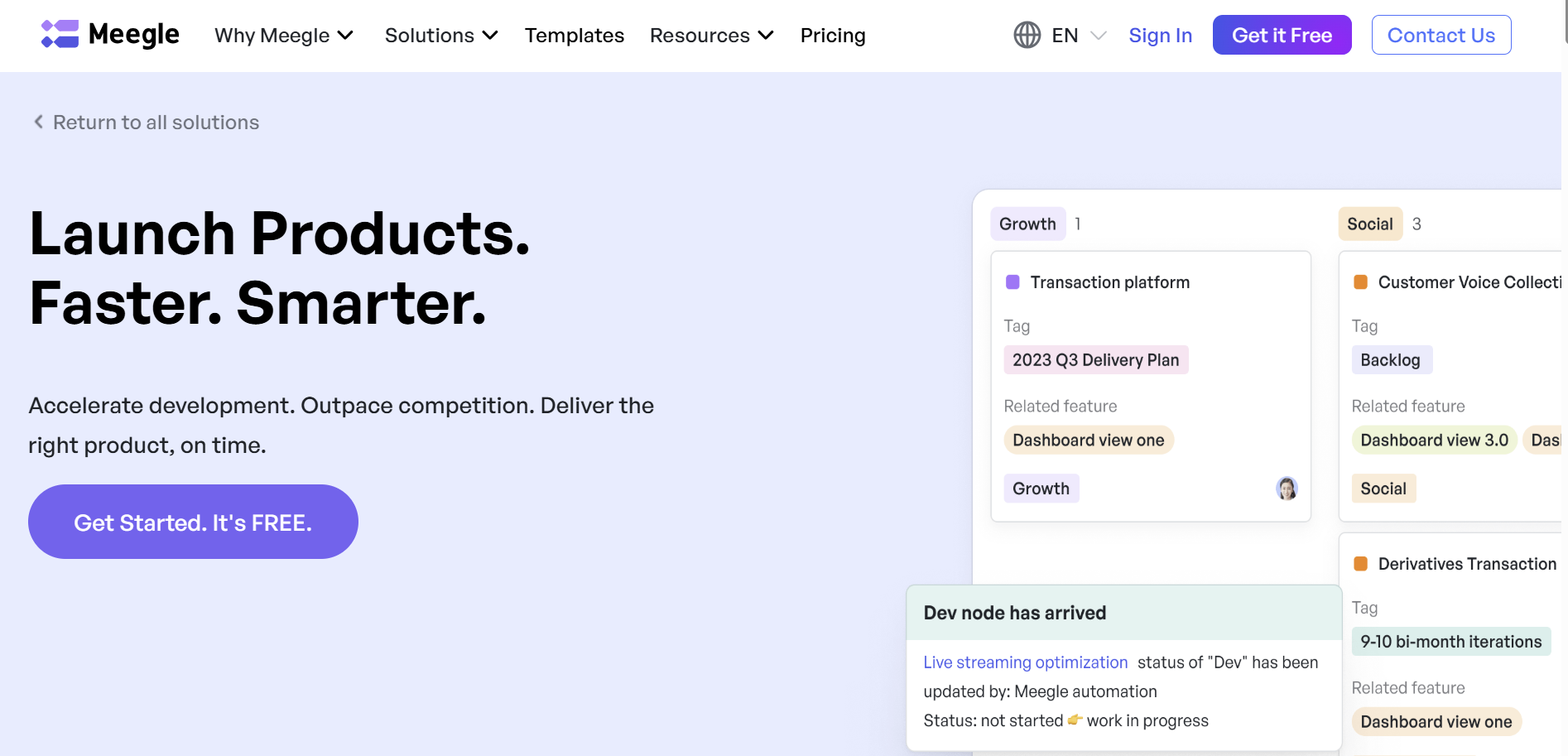 Meegle for product managers
Meegle for product managersMeegle supports product differentiation by helping teams streamline the end-to-end product development process with clarity and speed. Its visual workflows and customizable templates allow product managers to design unique processes, align cross-functional teams, and execute faster than traditional tools.
Unlike generic platforms, Meegle adapts to your product strategy—whether you're focused on innovation, cost leadership, or niche features. This flexibility empowers businesses to build products that truly stand out in competitive markets.
Stand out where it counts—discover how Meegle helps you build truly differentiated products today.
FAQs
1. How do product differentiation and product positioning differ?
Product differentiation is the process of distinguishing your product from competitors by emphasizing unique features, benefits, or attributes that set it apart in the market.
In contrast, product positioning is about how you want your target audience to perceive your product relative to competitors.
While differentiation focuses on what makes your product unique, positioning is about crafting a clear image or identity in the customer's mind. Both strategies are essential for building a strong brand and gaining a competitive advantage.
2. What role does pricing strategy play in product differentiation?
Pricing strategy is a critical component of product differentiation. A differentiated product often justifies a premium price by offering unique features, superior quality, or added value that competitors do not provide.
However, the price must align with customer perceptions. Value-setting prices too high without clear differentiation can lead to customer disappointment, while underpricing can undermine perceived uniqueness. Effective pricing reinforces your product differentiation strategy and helps attract the right market segment.
3. How often should a product differentiation strategy be revisited and updated?
A product differentiation strategy should be reviewed at least annually and assessed quarterly to ensure it remains relevant. Market conditions, customer preferences, and competitor actions are constantly evolving, so regular reviews help you adapt your differentiation strategy, address new opportunities, and maintain a competitive edge.
4. How can early-stage startups with limited budgets effectively differentiate their products?
Early-stage startups can differentiate by deeply understanding customers and targeting niche markets. Identify unmet needs through research, then deliver unique, high-value solutions. Focus on real value, not surface changes, and use creative, budget-friendly marketing to stand out. Fast iteration based on customer feedback ensures impact without overspending.
5. What are the common risks of over-differentiating, and how can you avoid them?
Common risks of over-differentiating include:
- High R&D and marketing costs
- Brand confusion if messaging is unclear
- Fast imitation by competitors
- Operational inefficiencies from managing too many variations
- Losing customers if the product becomes too niche
To avoid these risks, focus on genuine customer needs, and make sure differentiation is meaningful and clearly communicated, and regularly review your strategy to stay aligned with market demands.
The world’s #1 visualized project management tool
Powered by the next gen visual workflow engineRead More
Check All BlogsStart creating impactful work today



